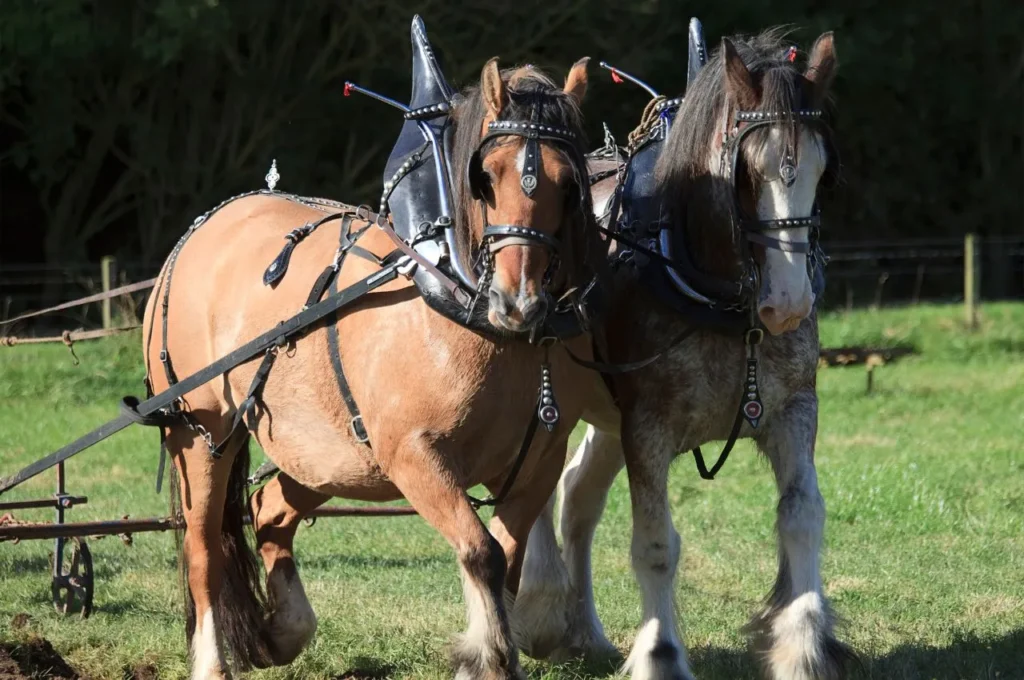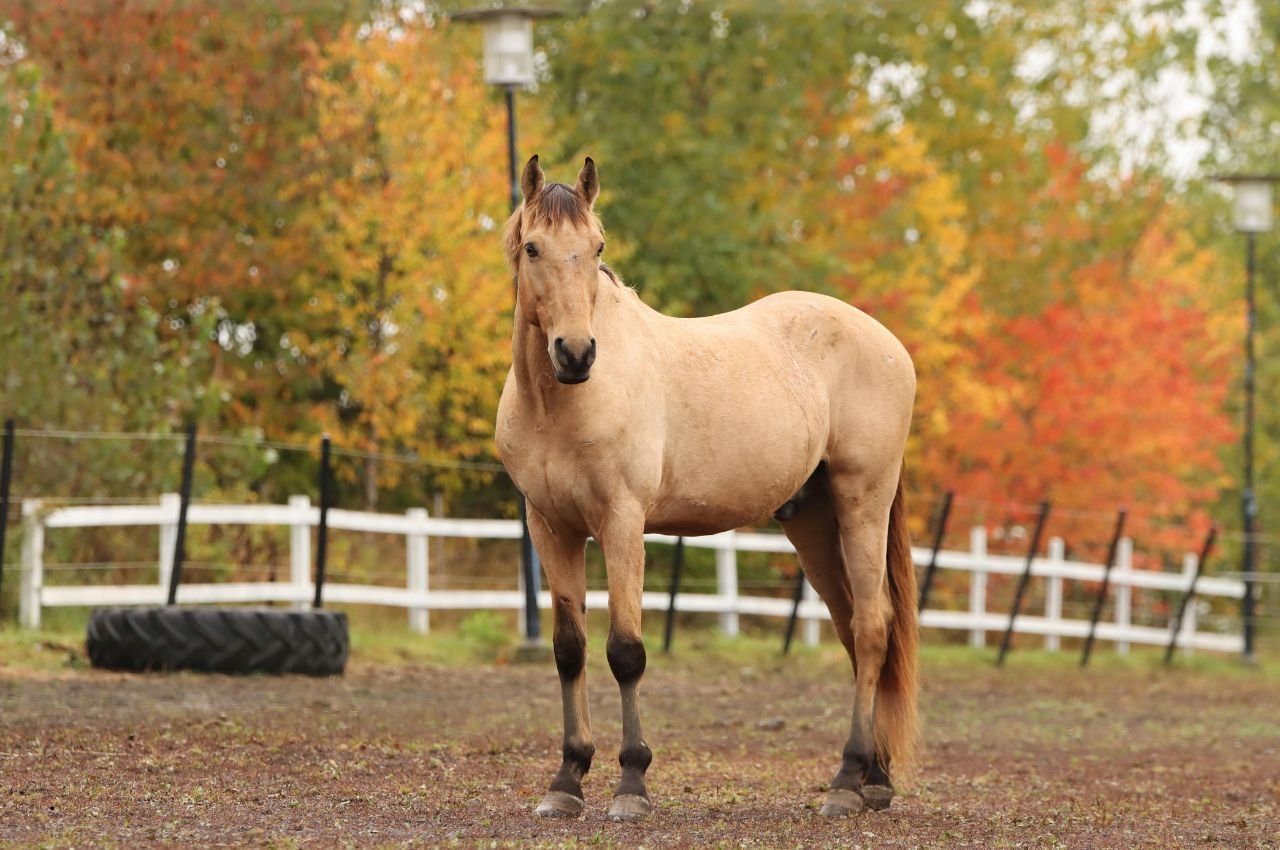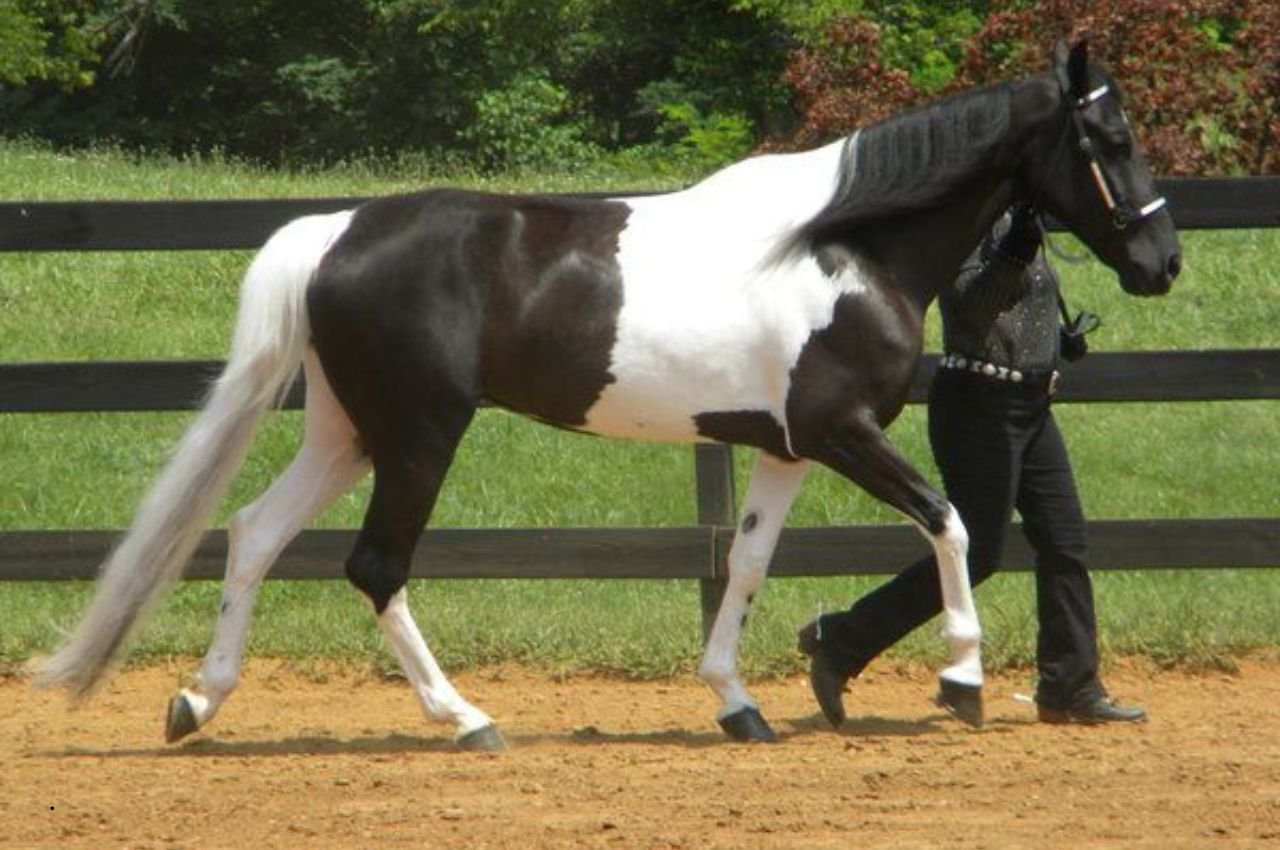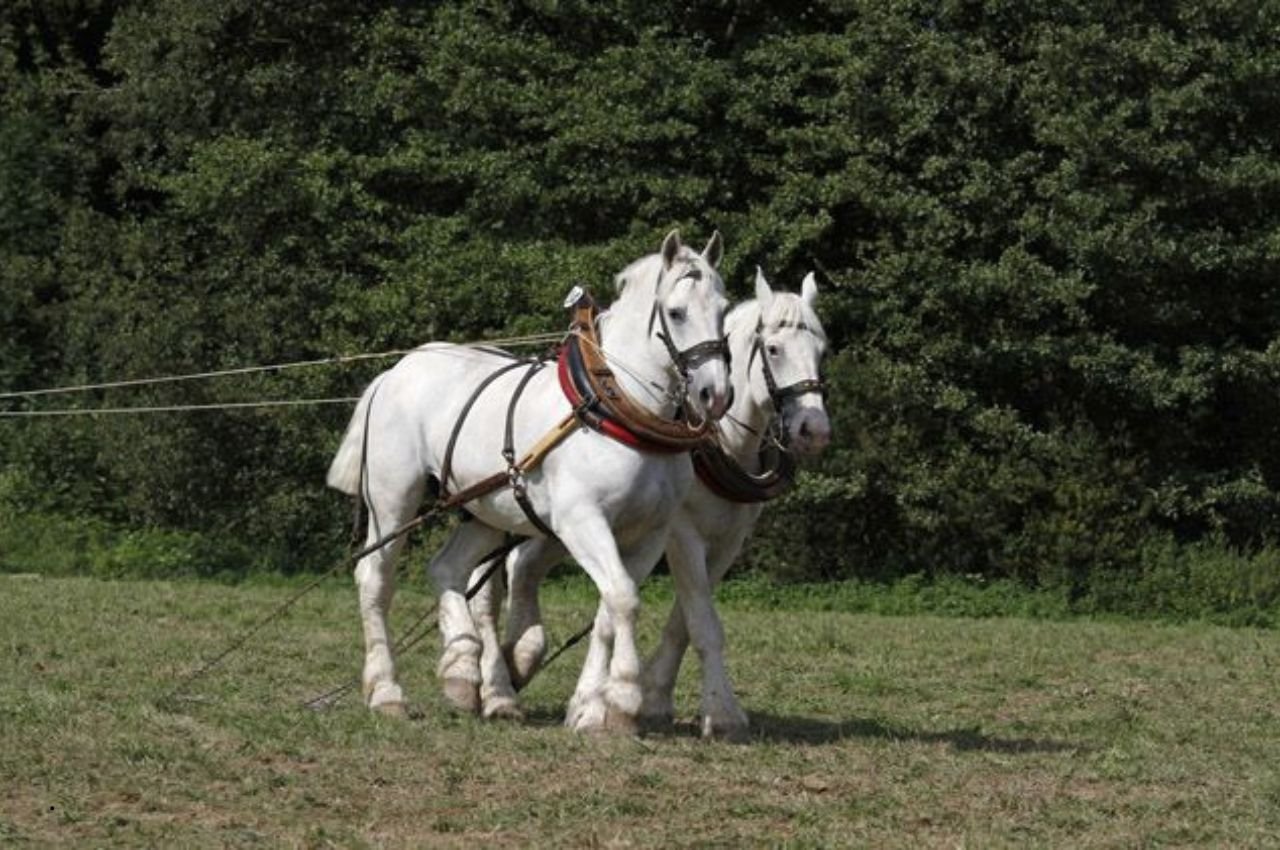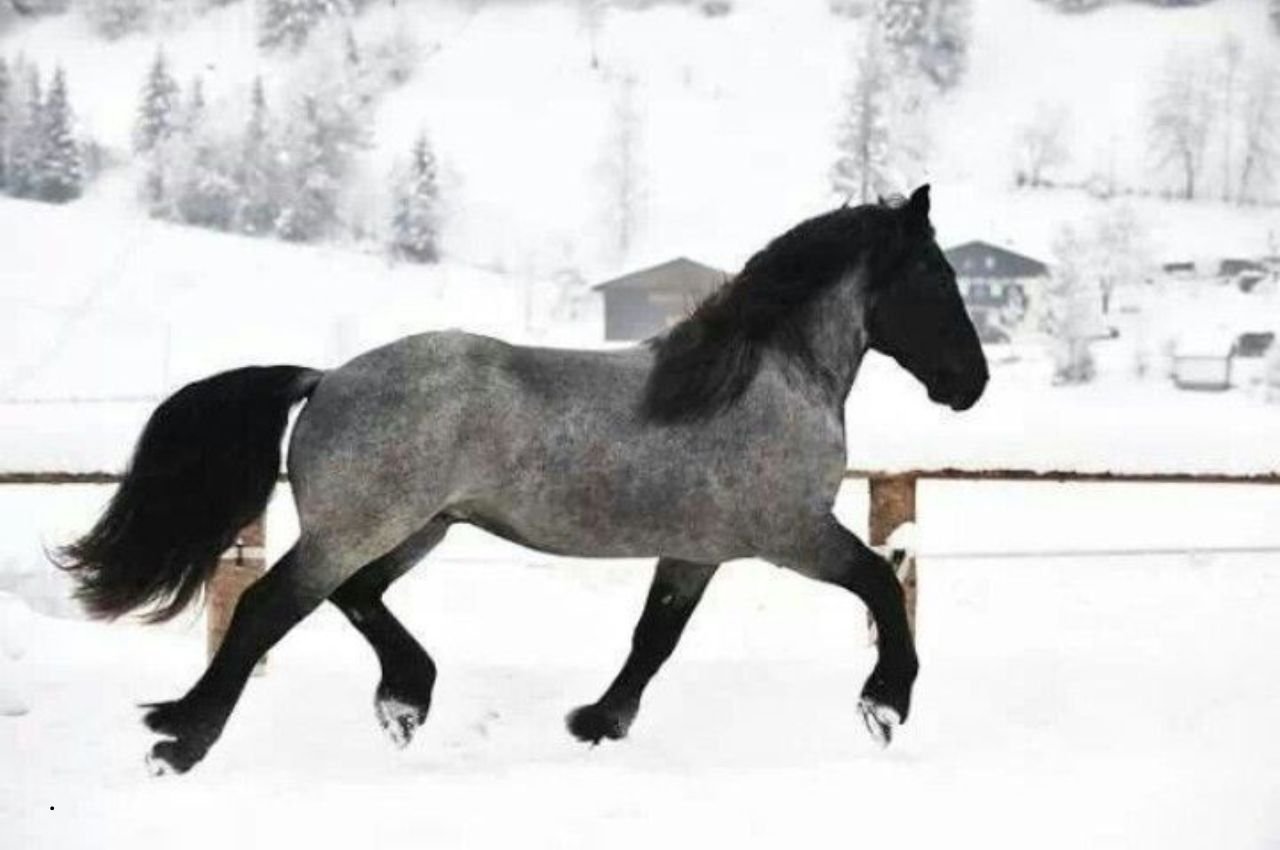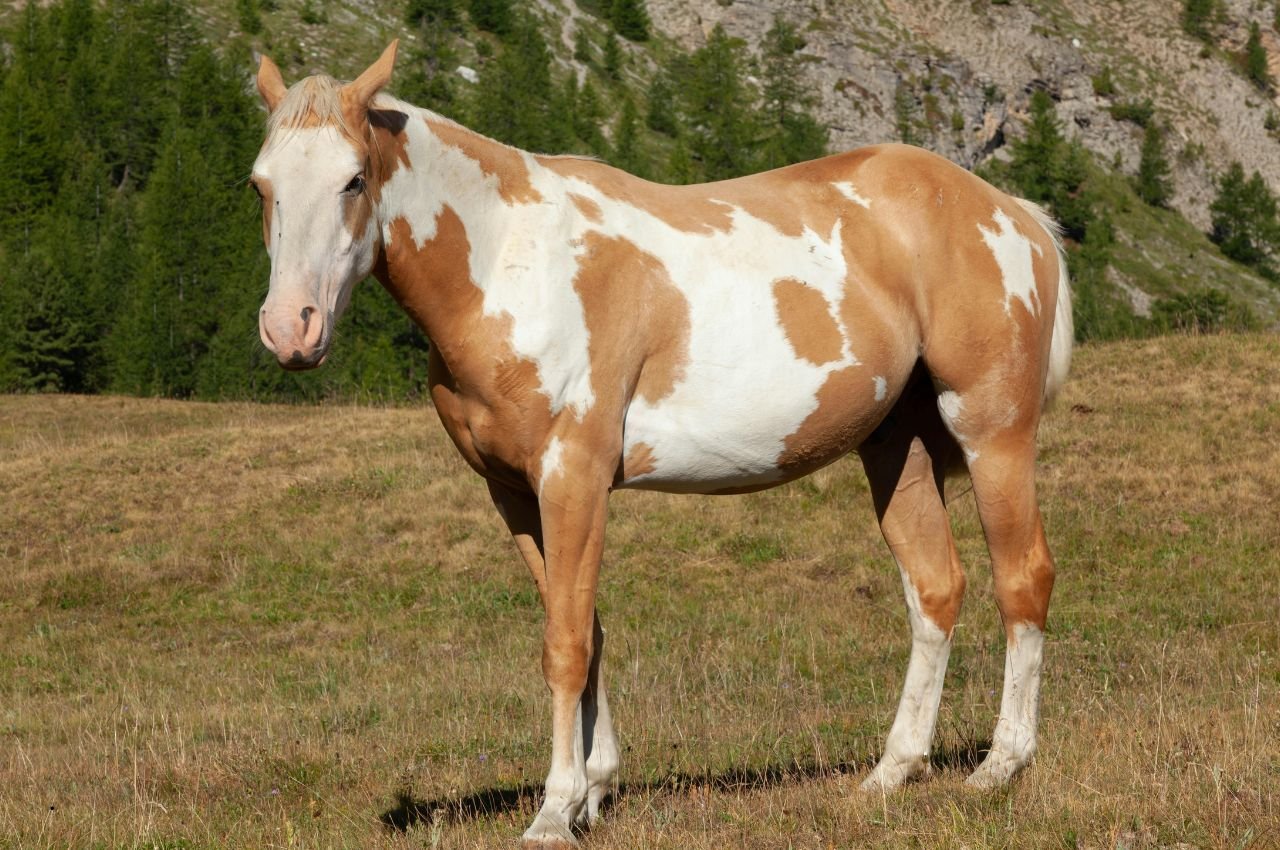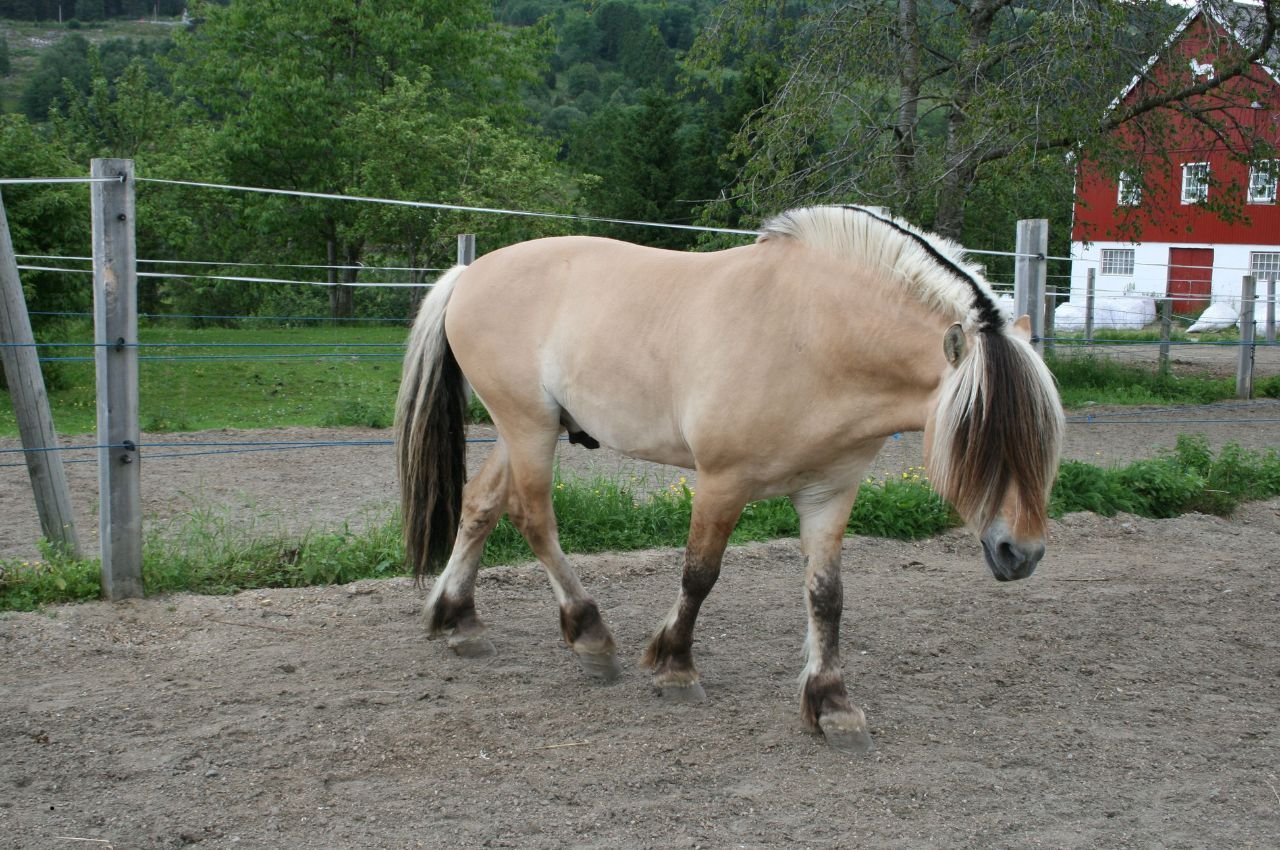The Clydesdale horse is not only one of the most recognizable and beloved horse breeds worldwide but also a living testament to centuries of tradition, strength, and grace. With their imposing size, distinctive feathering on the lower legs, and majestic presence, Clydesdales have captivated horse enthusiasts for generations. Historically, they were bred to serve as powerful draft horses on farms and in industries. Today, they stand as icons of strength and beauty, often featured in commercials, parades, and competitions.
In this comprehensive guide, we will explore every aspect of the Clydesdale horse—from its fascinating history and unique characteristics to its temperament and the best practices for care. Whether you’re a first-time horse owner, an enthusiast, or considering getting a Clydesdale for your farm or stable, this guide will provide you with all the information you need.
What You’ll Learn
1. History of the Clydesdale Horse
The Clydesdale horse’s roots run deep into Scotland’s agricultural past, dating back to the 18th century. The breed’s development was deeply tied to the needs of the farming community, with an emphasis on creating a horse capable of handling the toughest tasks on the farm.
Early Origins and Development

The origins of the Clydesdale breed lie in the Clyde Valley of central Scotland, where the climate and terrain made it challenging for farmers to find horses capable of performing heavy draft work. In the 18th century, Scottish breeders began crossbreeding the native, smaller Scottish horses with larger, stronger horses from Flanders, Belgium, and Northern England, creating a new breed with superior strength and endurance.
At first, the Clydesdales were used for general farm labor, such as plowing fields, pulling carts, and hauling timber. These horses were essential in supporting the agrarian lifestyle that dominated Scotland’s economy. By the mid-1800s, their strength and utility had earned them a strong reputation as the “workhorses” of the region.
The Rise of the Clydesdale in the United States
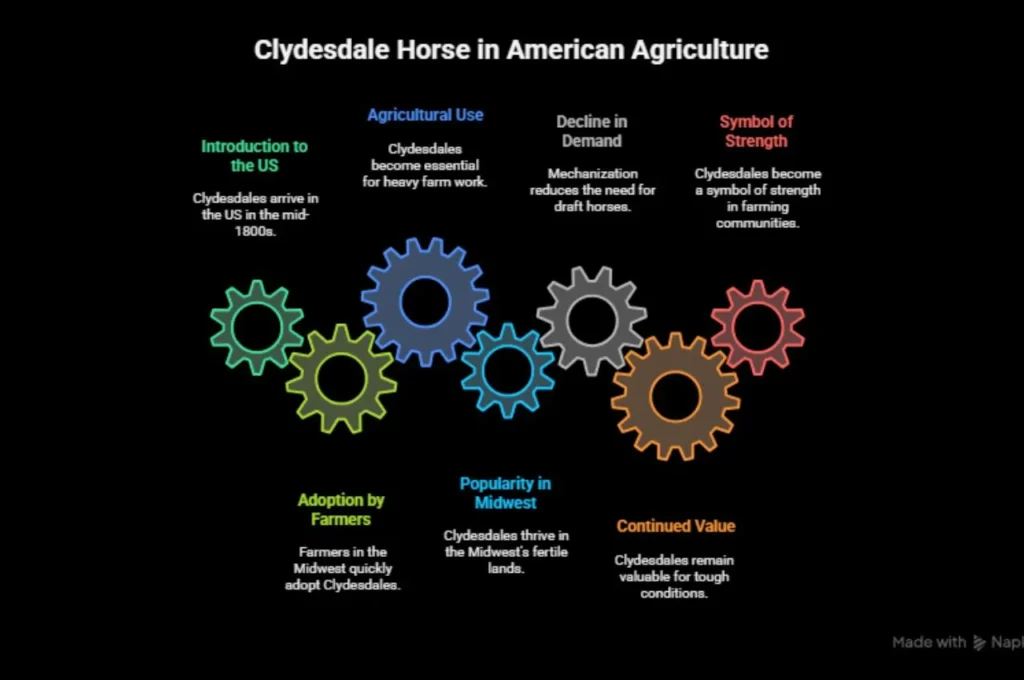
The breed made its way to the United States by the mid-1800s, where it was quickly adopted by farmers in the Midwest. Clydesdales were well-suited for heavy farm work, and their ability to pull plows and harvest equipment made them indispensable. By the early 20th century, Clydesdales were seen on farms and plantations throughout North America, where they helped shape the agricultural landscape.
The breed became especially popular in the Midwest, where the flat terrain and fertile soils were ideal for plowing and harvesting. As mechanized farming equipment became more prevalent, the demand for draft horses waned. However, Clydesdales continued to be valuable for their ability to work in tough conditions that machines could not reach. Even as their role as agricultural workers faded, Clydesdales remained a symbol of strength and power in farming communities.
Commercial Fame and Modern Times
In 1933, the Anheuser-Busch Brewery introduced Clydesdales into their advertising campaigns. The famous Clydesdale horses, pulling the iconic beer wagon, became a part of American pop culture. The horses were prominently featured in Budweiser commercials, which helped further cement their fame as a symbol of power, tradition, and American craftsmanship.
Today, Clydesdales are primarily known for their role in advertising, parades, and exhibitions. While they are still sometimes used in agricultural contexts and historical reenactments, their place in modern society is largely in the show world. They are revered for their majestic beauty and gentle demeanor, often found in competitions, fairs, and breed shows, where their size and elegance continue to captivate audiences.
2. Size and Physical Appearance
The Clydesdale is easily one of the most impressive and visually striking horse breeds. Their size, build, and unique features make them stand out in any crowd.
Height and Build

Clydesdales are known for their large size, with most standing between 16 to 18 hands (64 to 72 inches or 163 to 183 cm). Males are generally larger than females, and certain individuals may grow even taller. Clydesdales are renowned for their muscular frames and long, strong legs, which contribute to their ability to pull large loads.
Their large size and stature are the result of careful breeding, which focused on producing a horse capable of handling heavy agricultural work. This breed is built to work, with powerful haunches, a broad chest, and a strong, thick neck.
Weight and Proportions
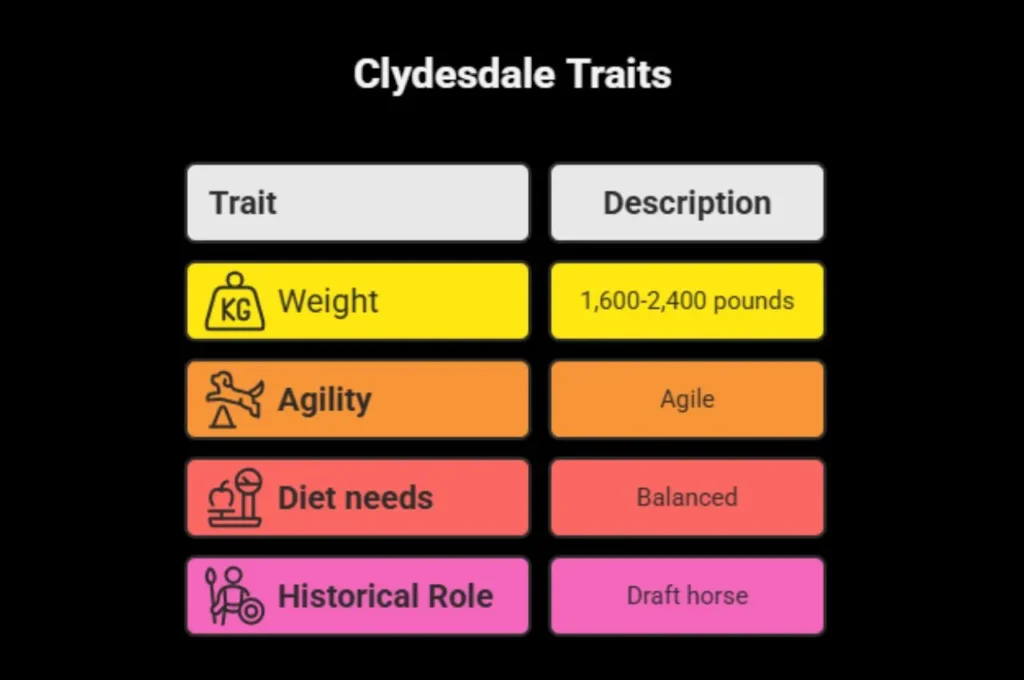
Clydesdales typically weigh between 1,600 to 2,400 pounds (725 to 1,090 kg). Due to their large bodies, they need a balanced diet to maintain a healthy weight. Their weight varies based on factors such as age, diet, and work level. However, the Clydesdale’s bulk is essential for its historical role as a draft horse.
Despite their large size, Clydesdales are surprisingly agile. They are often used in driving competitions, where their ability to pull precision maneuvers and navigate tight spaces is put to the test.
Coat and Color Variations
The classic color of the Clydesdale is bay, with a deep reddish-brown coat complemented by black points (legs, mane, tail). Other acceptable colors include black, chestnut, and gray. The white markings on their face, legs, and hooves are iconic features of the breed. These markings are part of what makes the Clydesdale so visually appealing.
One of the most distinctive features of the breed is the feathering on their legs. This long, thick hair growing below the knee and around the hooves is a hallmark of the breed. While feathering is most noticeable on the front legs, it is seen on the hind legs as well.
Distinctive Hooves
The hooves of the Clydesdale are particularly large and must be carefully managed due to the horse’s weight. Regular hoof care is essential to prevent problems such as laminitis, and proper shoeing is required to ensure that the horse remains stable and comfortable while performing tasks such as driving or pulling heavy loads.
3. Temperament and Behavior
Despite their imposing size, Clydesdales are often known for their gentle nature. Their temperament is one of the breed’s most appealing traits, as they are generally calm, patient, and social. These horses are typically well-suited for families and novice horse owners due to their docile demeanor.
Gentle Giants
Clydesdales are often referred to as “gentle giants” due to their remarkable patience and calm demeanor. While their size might initially intimidate some, these horses are incredibly gentle, especially when handled properly. They are known to be patient with children, making them excellent family horses and show horses. However, despite their gentleness, they still require experienced handling to ensure they are well-behaved.
These horses are highly intelligent, which makes them easy to train for various tasks. Clydesdales are quick learners and respond well to consistent, positive reinforcement. They can be trained for driving, plowing, and participating in equestrian competitions.
Social and Interactive Nature
Clydesdales are very social animals and generally enjoy the company of other horses. They are herd animals, and keeping them in the company of at least one other horse is ideal for their well-being. They thrive in environments where they can interact with other animals and humans, forming strong bonds with their caretakers.
Sensitivity
Despite their calm nature, Clydesdales can be sensitive to sudden noises or movements. Their natural instinct is to be cautious of unfamiliar situations, so introducing them to new environments gradually is important. Training them with patience and calmness is essential to avoid causing unnecessary stress.
4. Care and Maintenance
Caring for a Clydesdale requires careful consideration of their size, diet, exercise, and grooming needs. These horses require a stable environment, proper nutrition, and regular veterinary care to maintain their health.
Diet and Feeding Needs
Due to their large size, Clydesdales need a substantial amount of food to sustain their energy levels. A Clydesdale’s daily diet should consist of:
- High-Quality Hay: Clydesdales consume a significant amount of hay daily, often between 10 to 15 pounds per day. Timothy, orchard grass, or alfalfa hay is best for maintaining proper digestive health.
- Grain and Pellets: Clydesdales can also be supplemented with grains like oats, barley, or pelleted feed. Depending on their workload, they may require additional grain for energy. However, too much grain can lead to weight gain or colic, so it’s important to monitor their intake.
- Supplements: Joint health supplements are essential for a breed of their size. Omega-3 fatty acids, glucosamine, and chondroitin can help support their joints and muscles. Additionally, vitamin and mineral supplements may be necessary to ensure they are receiving all essential nutrients.
Exercise and Physical Activity
Although they are known for their size, Clydesdales need daily exercise to stay healthy and maintain their muscle tone. While they do not require the intense exercise levels of some other breeds, regular turnout in a large pasture and short daily walks or light driving sessions help keep their bodies in good shape. This exercise prevents stiffness, improves their cardiovascular health, and helps with weight management.
Grooming
Clydesdales have thick coats and long feathering on their legs, which require regular grooming to stay clean and healthy. Grooming helps maintain their appearance and also serves as a bonding activity between the horse and its handler. The steps involved in grooming a Clydesdale include:
- Brushing: Regular brushing is essential to keep their coat and feathering clean. Use a curry comb and a stiff brush to remove dirt and loose hair.
- Feathering Care: The feathering around their hooves should be cleaned frequently to avoid the buildup of dirt and moisture, which can cause skin infections.
- Hoof Care: Regular hoof trimming is crucial to prevent lameness and hoof problems. Clydesdales’ large hooves need professional care every 6 to 8 weeks.
- Bathing: While Clydesdales don’t require frequent bathing, they should be bathed occasionally, especially before shows or exhibitions. Use a gentle horse shampoo and ensure that the coat is fully rinsed and dried.
5. Breeding and Reproductive Care
Clydesdale horses are bred for their size, strength, and beauty, but breeding them requires careful consideration. Clydesdales can be quite expensive to breed, as the costs of proper veterinary care, feeding, and training can add up.
Breeding Considerations
When breeding Clydesdales, breeders focus on maintaining the breed’s signature traits: size, strength, and docility. Breeders look for horses with strong genetics, good health, and an excellent temperament to continue the high standards of the breed. Some common considerations include:
- Health screening: Clydesdales should be carefully screened for common hereditary issues, such as joint problems or laminitis.
- Genetic testing: Ensuring genetic diversity and avoiding inbreeding is important to maintain the long-term health of the breed.
6. Conclusion
The Clydesdale horse is one of the most awe-inspiring and beloved breeds in the world, thanks to its stunning appearance, gentle nature, and powerful history. While the role of these magnificent animals has evolved from agricultural work to more symbolic roles in advertisements and shows, their strength and beauty remain unmatched. With the right care, training, and environment, Clydesdales can thrive as both working horses and beloved companions.
Clydesdales continue to symbolize tradition, power, and grace, leaving a lasting legacy on farms, in history books, and on the screen. Whether you’re interested in showing a Clydesdale, using one for work, or simply appreciating its majesty, this breed offers a unique and rewarding experience for all horse lovers.
7. Clydesdale Horses: Useful Resources and Links
Clydesdales are one of the most iconic horse breeds in the world, known for their impressive size, striking appearance, and gentle nature. Whether you’re a horse lover, a prospective owner, or simply curious about this magnificent breed, there are numerous resources available to learn more about them. Below, we’ve compiled a list of useful links to help you deepen your knowledge of Clydesdale horses and everything from their care to their history.
1. Clydesdale Horse Associations and Official Websites
Clydesdale Horse Association
- Website: Clydesdale Horse Association
- What You’ll Find: The official Clydesdale Horse Association offers in-depth resources about the breed’s history, breed standards, and breeding programs. A great starting point for understanding the breed’s origins and their current conservation efforts.
American Clydesdale Association
- Website: American Clydesdale Association
- What You’ll Find: This is the official website for the American Clydesdale Association, which provides details about the breed’s role in the U.S., including registry information, events, and membership benefits for breeders and enthusiasts.
2. Breed Information and General Care
The Horse – Clydesdale Breed Information
- Website: The Horse – Clydesdale Information
- What You’ll Find: This article from The Horse covers a comprehensive overview of the breed, including its history, physical characteristics, and practical care tips for maintaining a healthy Clydesdale. A must-read for those new to the breed.
Horse & Hound – Clydesdale Horse Care
- Website: Horse & Hound Clydesdale Care
- What You’ll Find: This resource from Horse & Hound offers practical advice on how to care for Clydesdales. Whether you’re looking for tips on grooming, feeding, or health management, this site provides expert advice tailored to large horse breeds.
3. Budweiser Clydesdales: Commercial and Cultural Icon
Budweiser Clydesdales – Official Website
- Website: Budweiser Clydesdales
- What You’ll Find: The Budweiser Clydesdales have become one of the most famous symbols of the breed. Learn more about the history of these iconic horses and their role in the famous beer company’s advertising campaigns. Perfect for anyone interested in the cultural significance of the Clydesdale horse.
4. Veterinary Care and Health Tips for Clydesdales
Merck Veterinary Manual
- Website: Merck Veterinary Manual
- What You’ll Find: This comprehensive online resource offers detailed information on equine health, including specific care tips for large breeds like the Clydesdale. It covers common health issues such as joint problems, laminitis, and proper hoof care.
5. Clydesdale Breeding and Genetics
International Clydesdale Horse Association
- Website: International Clydesdale Horse Association
- What You’ll Find: The International Clydesdale Horse Association offers resources on Clydesdale horse ownership, events, and breed standards. This site is a valuable tool for those interested in breeding and maintaining a healthy gene pool for the Clydesdale breed.
6. Educational Articles and Show Information
Equine World UK – Clydesdales
- Website: Equine World UK
- What You’ll Find: This site offers detailed articles on a variety of horse breeds, including the Clydesdale. It provides useful insights into Clydesdale ownership, including information on their training and care in show settings.
Horse Illustrated – Clydesdale Horse Breed Profile
- Website: Horse Illustrated – Clydesdales
- What You’ll Find: Horse Illustrated features detailed breed profiles and useful articles. Their Clydesdale profile provides background on the breed’s history and modern-day uses, as well as tips for owning and caring for these majestic horses.
7. Clydesdale Breeding Information and Genetic Health
The Horse – Genetic Health Considerations
- Website: The Horse – Genetic Health
- What You’ll Find: This resource dives deeper into breeding Clydesdales, focusing on the importance of genetic health. It provides useful information on screening for genetic issues and considerations for breeding within the Clydesdale community.
8. Video Resources on Clydesdale Horses
If you prefer visual learning or want to see Clydesdales in action, the following videos will provide an excellent overview of various aspects of Clydesdale horse care, training, and grooming. Whether you’re a prospective owner, trainer, or simply a fan of this magnificent breed, these videos will give you a closer look at what it takes to care for and train these gentle giants.
8.1 Grooming and Care
- How Do You Properly Groom A Clydesdale Horse?
Learn the essential grooming techniques and tools to keep your Clydesdale looking its best.
Watch the video here - How to Groom Your Horse – Presented by Grandview Clydesdales
Tips on grooming your Clydesdale to maintain a shiny and healthy coat.
Watch the video here - Clydesdale Horse Grooming at The National Stallion Show, Perth, Scotland
Watch a live demonstration on grooming techniques during a major equine event.
Watch the video here
8.2 Training and Behavior
- Training A Clydesdale Horse – Breezy’s First Lesson
Follow Breezy, a young Clydesdale mare, as she begins her training journey.
Watch the video here - Training Our Rescued Clydesdale
Watch the progress of a rescued Clydesdale as he learns ground manners and gets ready for farrier visits.
Watch the video here
8.3 Hoof and Feather Care
- LIVE Chronic Clydesdale Hoof Care
A live session focusing on hoof care for Clydesdales.
Watch the video here - How to Oil Clydesdale Legs
Learn how to oil Clydesdale legs with sulfur and oil for proper maintenance.
Watch the video here - Clydesdale Feather Care
Tips on maintaining the long, thick feathering on Clydesdale legs.
Watch the video here
8.4 Farm and Lifestyle
- Clydesdale Horse Farm Tour
Take a virtual tour of a Clydesdale horse farm, learning about their history and daily care.
Watch the video here - Clydesdale Horse Spa Day + Stallion Gallops Through Pasture!
Watch a relaxing spa day for a Clydesdale filly and enjoy the sight of a stallion galloping through the pasture.
Watch the video here
Feel free to explore these informative videos to enhance your understanding of Clydesdales. Whether you’re looking to learn more about grooming, training, or simply want to see them in action, these visual resources will help bring the world of Clydesdales to life.
Frequently Asked Questions (FAQs) About Clydesdale Horses
What is a Clydesdale horse?
A Clydesdale horse is a large draft horse breed that originated in the Clyde Valley of Scotland in the 18th century. Known for their strength, size, and gentle temperament, Clydesdales were originally bred for farm work such as plowing fields, hauling carts, and pulling heavy loads. Today, they are widely recognized for their use in shows, parades, and advertising, notably in the Budweiser beer commercials.
What are the main characteristics of a Clydesdale horse?
Clydesdales are known for their impressive size, muscular build, and distinctive feathering on their lower legs. Key characteristics include:
Height: Typically stands between 16 and 18 hands (64 to 72 inches) tall.
Weight: Ranges between 1,600 to 2,400 pounds.
Coat Colors: Most commonly bay, but also black, chestnut, and gray.
Temperament: They are known for their gentle, patient, and friendly nature, often referred to as “gentle giants.”
Feathering: Long hair on the lower legs, particularly around the hooves.
Are Clydesdales good for beginners or first-time horse owners?
Yes, Clydesdales are typically gentle and easy-going, making them suitable for beginner horse owners. Their calm demeanor and patience with children or new handlers make them a popular choice for people with less experience. However, due to their large size, it’s important for beginners to receive proper training in handling large draft horses to ensure safety for both the horse and owner.
How much space do Clydesdales need?
Clydesdales are large horses, so they require ample space to move around. Ideally, they should have:
A spacious stall with enough room for them to turn around and lie down comfortably.
Access to a large pasture or paddock to allow for daily exercise and grazing. Clydesdales require a lot of room to stretch their legs and maintain good physical health.
An enclosed area for regular grooming and training, ensuring they are safe while receiving attention.
What is the lifespan of a Clydesdale horse?
Clydesdales generally live for 25 to 30 years with proper care. However, their lifespan can be influenced by factors such as health, diet, exercise, and genetic predisposition. Regular veterinary visits and proper management of weight and joint health can help extend their life expectancy.
What kind of diet do Clydesdales need?
Clydesdales require a nutrient-rich diet that supports their large size and high energy levels. Their diet should consist of:
High-quality hay: Clydesdales typically consume 10 to 15 pounds of hay per day.
Grains: Depending on their activity level, they may also need grains like oats or barley to maintain energy.
Supplements: Joint supplements like glucosamine or chondroitin can support their large frames and prevent joint problems. Vitamin and mineral supplements are also recommended to maintain overall health.
Fresh Water: Clydesdales should always have access to clean, fresh water to stay hydrated, especially during hot weather or when working hard.
How much exercise do Clydesdales need?
Despite their size, Clydesdales require regular exercise to maintain muscle tone, flexibility, and overall health. Daily turnout in a large pasture is essential, and they benefit from moderate activities such as light driving, walking, or trotting. They may not require the intense exercise routines of smaller breeds but should still get plenty of physical activity to avoid obesity and joint issues.
How do you groom a Clydesdale horse?
Grooming a Clydesdale is an important part of their care routine. Due to their size, feathering, and thick coats, they need regular grooming. Here are some steps to follow:
Brushing: Use a curry comb to loosen dirt and a dandy brush to remove dirt and debris from their coat. Brush their coat and feathering regularly to keep them clean and healthy.
Feathering Care: The feathering on their legs can trap dirt and moisture. Make sure to clean the feathering around their hooves regularly to prevent infections.
Hoof Care: Trim their hooves every 6 to 8 weeks. Clydesdales have large hooves that require regular attention to prevent discomfort and lameness.
Bathing: Bathe your Clydesdale occasionally, especially before shows or exhibitions. Use a gentle horse shampoo and rinse thoroughly.
Are Clydesdales easy to train?
Yes, Clydesdales are highly trainable. Their intelligence and docile nature make them responsive to positive reinforcement and consistent training. They excel in various activities, such as:
Driving competitions: Clydesdales are often trained to pull carts and participate in driving events.
Riding: They can also be trained for light riding, although due to their size, they may not be the best choice for riders who are not experienced.
Show jumping and exhibitions: Clydesdales are also trained to participate in shows where they demonstrate their size and abilities.
However, while they are generally calm and easy-going, Clydesdales require early socialization and consistent training to help them adapt to new environments, noises, and tasks.
Can Clydesdales live in warm climates?
Clydesdales can live in warm climates but require special care. Due to their thick coats and feathering, they are better suited for cooler weather, and extra steps should be taken to ensure their comfort in warmer climates:
Shelter: Ensure that they have a well-ventilated barn or shelter where they can escape the heat.
Hydration: Clydesdales need plenty of fresh, cool water to stay hydrated in hot weather.
Clipping: In some cases, Clydesdales may benefit from having their coat clipped during the summer to keep them cooler.
Exercise: Avoid strenuous exercise during the hottest parts of the day. Early morning or late evening is the best time to work with them in hot climates.
How often do Clydesdales need veterinary care?
Clydesdales, like all horses, require regular veterinary care to maintain their health. Typical care intervals include:
Annual Checkups: A yearly visit to the vet for vaccinations, deworming, and a general health check-up.
Hoof Trimming: Hooves should be trimmed every 6 to 8 weeks to ensure they stay healthy and balanced.
Joint Health Monitoring: Given their size, Clydesdales are more prone to joint problems such as arthritis. Regular checks and proactive care, including joint supplements, can help maintain mobility.
Dental Care: Horses, including Clydesdales, need their teeth checked regularly, typically once or twice a year, to prevent issues with chewing and digestion.
Are Clydesdales prone to any health problems?
Due to their large size, Clydesdales can be prone to specific health conditions. Some common health issues in Clydesdales include:
Laminitis: A painful condition affecting the hooves, often caused by obesity, poor diet, or injury.
Joint problems: Their heavy weight puts extra strain on joints, so they may develop conditions like arthritis or joint stiffness.
Obesity: Due to their large appetites, Clydesdales can become overweight if not managed carefully, leading to complications such as laminitis and heart issues.
Respiratory problems: Like other large breeds, Clydesdales are susceptible to respiratory issues, especially if kept in damp or poorly ventilated areas.
How much do Clydesdales cost?
Clydesdales are one of the more expensive horse breeds, and their price can vary significantly depending on factors such as:
Age: Young, well-bred horses with good training tend to cost more.
Training: A Clydesdale that has been trained for specific tasks, like driving or riding, may fetch a higher price.
Pedigree: Horses with a strong pedigree or those that come from champion lines are generally more expensive.
Location: Prices may vary by region, with Clydesdales in high-demand areas or certain countries costing more.
On average, a Clydesdale can cost between $5,000 and $15,000, though elite horses from top bloodlines may cost much more.

